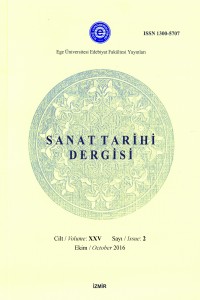Abstract
Her mezâr taşı, sahibinin kendi hikâyesini anlatır aslında. Bizim anlam yüklememize gereksinim duymadan verir mesajını. Sonuç hep aynı da olsa farkları vardır bu mesajların. Bazen kısa, bazen uzun satırlara sığdırılmış özgeçmişler; geçmişte yaşanmış acıyı, amansız hastalığı, genç yaşta gelen ani ölümü, Allah’tan ‘afv dilemeyi, insanlardan du‘â talebini, peygamberden şefâ‘at isteğini, Allah’ın bâkî, yaradan ve yardımcı olduğunu, yatanın sosyal statüsünü, mesleğini anlatır. Başka hiçbir medeniyete nasîb olmayan bu zengin anlatım biçimleri, kütleyle de somutlaşır. Gövde, başlık, tepelik biçimleri ve bezeme, taşın Osmanlılığına vurgu yapar. Bu vurgu, belki de son yıllarda kamuoyunda defalarca gündeme getirilmesi nedeniyle, konunun uzağındaki kişilerce bile anlaşılır olmuştur.
Evet, belki dedelerimizin/nenelerimizin mezâr taşlarından çoğunu kaybetmiştik ama kalanlar geçmişe kuvvetli bir ışık tutmaya yetmişti. İşte bu makale, Eşme köylerindeki mezâr taşlarının bu ışığa bir hüzme sağlaması amacıyla yazılmıştır.
References
- Bayrakal, Sedat (2016), Uşak’ta Osmanlı Mezâr Taşları, İzmir: Ege Üniversitesi Basımevi.
- İşli, H. Necdet (2009), Osmanlı Serpûşları, İstanbul.
Selection From The Stones In The Village Graveyards In Eşme District (Uşak) In The Context Of Content
Abstract
Each gravestone actually tells the story of its owner. It gives its message without the need for our attributing any meaning to it. Although the consequence is always the same, these messages have differences. It tells the stories that are fitted in sometimes short and sometimes long lines, past pains, incurable diseases, sudden death at a young age, asking for Allah’s mercy, asking for people’s prayers, intercession of the prophet, that Allah is permanent, the creator and helper, and the social status and profession of the dead person. These rich wordings that are not vouchsafed for any other civilization become concrete with their mass. Body, title, cap styles and decoration emphasize the Ottomanship of the stone. This emphasis has started to be understood even by people who are far from the subject as it has been repeatedly brought to the agenda in public opinion in recent years.
Yes, maybe we lost many of the gravestones of our grandfathers/grandmothers, however, the remaining part was sufficient to shed light on the past. This article has been written in order to ensure that the gravestones in Eşme villages provide a beam to this light.
Keywords
References
- Bayrakal, Sedat (2016), Uşak’ta Osmanlı Mezâr Taşları, İzmir: Ege Üniversitesi Basımevi.
- İşli, H. Necdet (2009), Osmanlı Serpûşları, İstanbul.
Details
| Journal Section | RESEARCH |
|---|---|
| Authors | |
| Publication Date | December 30, 2016 |
| Published in Issue | Year 2016 Volume: 25 Issue: 2 |


